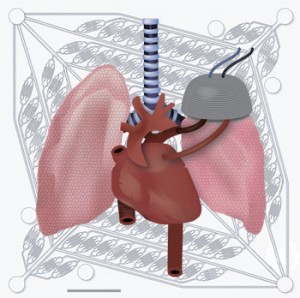Artificial lung technology could reduce the death rate for patients awaiting a lung transplant, say US scientists.
Advanced lung disease is characterised by an inability to remove carbon dioxide from the blood and reduced oxygen uptake efficiency. A shortage of donors can mean long delays and high mortality rates for those awaiting a transplant. The only technology available to aid sufferers during this time is based in intensive care units, hindering quality of life.
Now, Joseph Vacanti and coworkers at Massachusetts General Hospital, Boston, have developed a device that achieves the CO2/O2 gas exchange that, when implanted in the body, could allow patients more freedom when awaiting a transplant. Their design is a microfluidic branched vascular network through which blood flows, separated from a gas-filled chamber by a silicone membrane less than 10um thick. The network is formed by casting polydimethylsiloxane, a biocompatible polymer, on a micro machined mould.

A device that achieves carbon dioxide/oxygen gas exchange could allow patients more freedom when awaiting a lung transplant
Link to journal article
Lung assist device technology with physiologic blood flow developed on a tissue engineered scaffold platform
David M. Hoganson, Howard I. Pryor II, Erik K. Bassett, Ira D. Spool and Joseph P. Vacanti, Lab Chip, 2011
DOI: 10.1039/c0lc00158a










